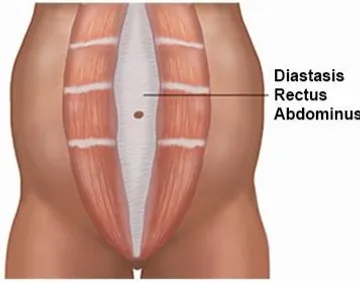Medical Disclaimer:
THIS WEBSITE DOES NOT PROVIDE MEDICAL ADVICE
The information, including but not limited to, text, graphics, images, and other material contained on this website are for informational purposes only. No material on this site is intended to be a substitute for professional medical advice, diagnosis or treatment. Always seek the advice of your physician or other qualified healthcare provider for any questions you may have regarding a medical condition or treatment before undertaking a new healthcare regimen. Never disregard professional medical advice or delay in seeking it because of something you read on this website.
I have a separation in my abs, now what?
A hot topic recently has been a diagnosis called diastasis rectus abdominus, commonly known as a DRA. This is a medical way of saying, you have a separation in your ab muscles that’s bigger than what was there before. It is a common misunderstanding that this diagnosis is only for women who have been pregnant or are postpartum. But fun fact, DRA can affect men too!

The true definition of DRA is a little tricky because research shows a lot of different ways to diagnose the separation. I’ll show you one way to measure to know if you do in fact have a DRA and what makes people at risk, what it means for you and your workouts, and what you can do about it.
One easy way you can check for a DRA:
This test is best performed with the help of a second person but you can perform it alone!
- Lie on your back with both of your knees bent and flat on the floor.
- Lift your shirt up so that your belly is exposed.
- Place your arms across your chest.
- Inhale and on your EXHALE, gently lift your head and your shoulders off the floor like you are performing a mini crunch, avoid holding your breath.
- Look at the middle of your belly and first, see if you notice any bulging or tenting in the middle of your belly. Return to your starting position.
- Using one arm only and leaving the other arm across your chest, inhale and on your EXHALE lift your head and shoulders off the floor.
- Gently hold this position while continuing to breathe and use your fingertips horizontally to assess how wide your separation is from side to side.
- Do this above your belly button, at the level of your belly button, and below your belly button. (If you have another person around, you can ask them to gently use their fingers horizontally to assess the separation).
If you notice bulging or tenting, or if your separation is greater than 2 finger-widths apart you may need to see a pelvic health provider to assist you in your exercise goals. This test can be performed by both men and women and it should be PAINLESS. If there is pain in your belly while performing this test, you may need to see your primary medical provider.
One way a DRA is defined is if the separation you feel is greater than 2 finger-widths. According to research, the technical definition is 3.0cm or more (but I don’t expect you to measure this at home). Using the finger width method is a “rough estimate.” However, if you notice a bulge or tenting in your abdomen with your test or if you notice this bulging during your day-to-day activities or workouts, you would also benefit from assistance with your abdominals.
So what puts you at risk for a DRA?
Common risk factors include:
Men with abdominal obesity
People who perform full sit ups/crunches regularly
People who have had multiple pregnancies
People who had a pregnancy with multiples
People who had a higher maternal age
People who had higher maternal weight gain
People who had pregnancies with a higher baby weight
Abdominal Aortic Aneurysm
Hernias
These risk factors basically cause a stretch to the ab muscles that causes the tissue to separate. If you experience pregnancy, there is an additional hormone, called relaxin, that makes this tissue even weaker!
So now what?
You’ve done the test at home and you think you may have a DRA…
The good news is, there are a lot of options to help you!
For starters, make sure you don’t have any flags that warrant a medical screening.
This may include:
Fever
Constipation and/or bloating
Nausea and/or Vomiting
Rapid heart rate
Hernia bulge growing quickly
Severe pain, swelling or discoloration at the hernia site
If you experience any of these symptoms, contact your primary or OB GYN medical provider as soon as possible or go to your nearest emergency room.
Now, if you do not have those symptoms listed above in relation to your DRA, it is time to work on a few things to help you reach your goals!
Basic Tips for DRA:
- Avoid holding your breath during your workouts or when lifting any heavy objects (this puts pressure on your belly)
- Avoid straining with your bowel movements

(This also puts pressure on your belly)
- Avoid crunches or full sit-ups until you can control your breath and any tenting or bulging in the abdomen
- Avoid arching your low back during lifting or other exercise
Commonly asked questions:
Should I be wearing a belly binder?
I don’t recommend using an abdominal binder unless you are 8 weeks or less postpartum.
Do I need surgery?
Surgery is generally not the first option to treat DRA. The current recommendations for DRA treatment involve noninvasive options first, like weight loss, exercise, and physical therapy. If these treatments do not help after one year, you may be a surgical candidate. These options can be discussed with your primary medical provider.
If these tips feel like a foreign language to you or you feel lost on where to start with your workouts, then I suggest seeing a pelvic health and/or obstetric physical therapist (PT).
Here is a list of resources to help you manage your goals:
- Come see me at Be Ready PT at either of our Nashville or Brentwood, TN locations
Schedule a Call Here to Make an Appointment. Put “Dr. Colleen” or “Pelvic PT” in the notes.
To Learn more about Pelvic Health care at Be Ready PT, go here.
- You can always ask your OB-GYN provider for a referral to a pelvic health and/or obstetric PT
- You can use the directories I’ve included below to find a PT near you who has training in these topics areas.
OR
https://www.mypfm.com/find-a-pt
Written by: Colleen Gensheimer, PT, DPT
References:
- Xu, Lisa. Termly. Medical Disclaimer Examples. 28 Dec 2020. Accessed online 2 Feb 2022. . (https://termly.io/resources/articles/medical-disclaimer-examples/).
- American Physical Therapy Association, SOWH, CAPP-OB Committee. Intrapartum Topics of Pregnancy. May 2021. (162).
- American Physical Therapy Association, SOWH, CAPP-OB Committee. Advanced Topics of Pregnancy. May 2021. (6, 8, 14, 22, 78, 159-173).
- Croghan, Ann. Early Cesarean Rehab. MyPFM.com. Accessed online 2 Feb 2021.
- Diastasis Rectus Abdominus. Physio-pedia. Accessed online 2 Feb 2022. https://www.physio-pedia.com/Diastasis_Recti_Abdominis.
- Inguinal Hernias. John Hopkins Medicine. Accessed online 1 Feb 2022. https://www.hopkinsmedicine.org/hernia_center/hernias_medical_emergencies.html


